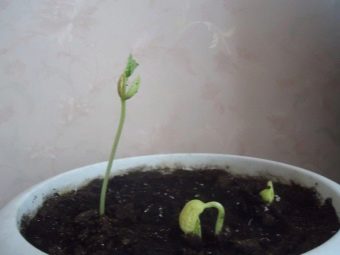How to sprout beans?

Nowadays, many people are concerned about maintaining a healthy lifestyle, which will allow them to preserve youth and beauty for many years. One of the main aspects is proper nutrition, which includes as many varied beneficial vitamins and trace elements as possible. People try to choose natural products, preferring them to such delicious, but harmful sweets. Adherents of healthy lifestyles are not paid attention to the beans, which is considered one of the most useful legumes.
Features of culture
Beans are an annual herb that belongs to the legume family. Vegetable came to our country from South America, quickly adapting to the climate of the middle belt. An adult plant looks like this: a climbing or upright long stem, stiffened at the bottom. Triple-leaved pinnate leaves are located along its length, moth-like flowers grow on elongated tassels.
The shade of colors can vary depending on the variety - from bright purple to white. Long fruits can be both straight and curved, in two valves is from 4 to 8 oval seeds (beans).
There are at least one hundred different types of beans that can be classified in various ways. Depending on the destination of the beans are divided into several varieties.
- Grain (shelling). This is a feed crop, in which only the grains themselves are edible.
- Sugar (asparagus). In the food using the whole pod together with the seeds. Use both fresh and after heat treatment.
- Semi sugar. Before eating, remove hard fibers from such pods.
- White. Eat only white seeds.
- Curly (red). Fruits of dark red are eaten, and the sprout itself also performs a decorative function, wrapping around arbors and benches on the site.
- Black. Seeds of such beans have a special flavor of smoked meat.
- Pod. As in the case of asparagus beans, the whole fruit with seeds is eaten.
- Decorative. Such a plant in the form of a large loach is planted solely for beauty.
Also in appearance are distinguished curling, polulushayusya and bush beans. And depending on the time of ripening of seeds, it is divided into late, mid-ripening and early ripening. The composition of any type of beans includes vitamins of group B, E, K, C, PP and A, antioxidants and various trace elements. The high content of iodine, potassium, magnesium and phosphorus, as well as amino acids and mineral salts makes it a welcome guest on any table. The calorie content of the vegetable is as much as 300 kcal per 100 g, but it is often used in the diet because of the high content of vegetable protein (21 g per 100 g of the finished dish).
The use of multi-colored seeds is not limited to the fact that they have a lot of protein. Beans regulate the amount of sugar in the blood, so it is very useful for diabetics. It stimulates the bowels, helps with constipation. Recent studies have shown that saponins contained in vegetables are useful in the fight against cancer, and the high content of antioxidants helps preserve youth and healthy skin. Many varieties of raw beans contain a toxic lysine, so improper cooking can lead to severe poisoning. In addition, excessive consumption of legumes leads to increased gas formation, which is not painful, but very unpleasant.
Nevertheless, the thoughtless use of even such a useful culture can cause some harm to human health.
Sprouting technology
Most often, home-grown beans need to be germinated at an accelerated rate in order to use it in various salads and snacks. But sometimes it is necessary to obtain seedlings, which will then be planted in open ground. This can be done in two different ways, which are almost not different from each other.
To seedlings
In order to grow bean seedlings at home, and then plant it at the dacha, only the seeds themselves, a wide flat plate and a thin fabric (or thick gauze) are needed. Seeds are sifted and washed with warm running water. All beans with traces of mold and damage must be removed so that at the seedling stage they do not bring various diseases and fungus to the rest of the sprouts. On a wide plate is laid out cloth, richly moistened with warm water, and one layer of clean, moist seeds. Top seeds are covered with a second piece of damp cloth, and the dish is placed in a warm place with a temperature of 25 degrees and above.
After some time, when both pieces of fabric are dry, the seeds should be well washed, without damaging them, and then repeat the procedure for laying on the dish. After 2 days of such repetitions, the first seedlings should appear in the beans. Such seeds can be planted in wooden or plastic boxes with soil.
Beans from germinated seeds grow quickly enough and brings a rich harvest.
For eating
For the consumption of germinated beans in the food will need the beans themselves, a glass jar and plain water. Seeds are carefully washed and sorted, and then poured into a deep jar. From above, they are filled with warm water and kept there for about five hours, after which the water is drained and the seeds are washed thoroughly again. This will remove even imperceptible to the human eye contamination, and the vegetable will be edible even in its raw form.
The prepared moist seeds are again poured into the jar, its neck is covered with thick gauze, and the whole structure is retracted in a warm place. After 5-7 hours, the jar must be removed, the beans washed and, again covering with gauze, removed in heat. The germination of the vegetable takes 1.5-2 days, after which the first shoots appear. Every 5-7 hours, the beans must be removed and gently rinsed. Store sprouted beans can be in the refrigerator for three days.
If you germinate beans in the light, it will have a higher content of vitamin C, and if in the dark, then vitamin B2.
Possible mistakes
Sometimes all the germination conditions are met, and the beans do not germinate on either the second or the third day. There may be several reasons for this.
- Seeds harvested last year from planted beans can be damaged by a pest. Most often it is a weevil that eats away the core of the seeds so that from the outside it remains indistinguishable from a healthy culture. Inside such a bean is just empty, so the sprout, it can not give.
- In addition to damage by pests, the mother plant, which gave the seeds, could be affected by various diseases. Transmitted to seeds, such diseases do not allow for good seedling.
- Sometimes the cause may be excessive or insufficient temperature. The optimum temperature for bean germination is +25. If the temperature is insufficient, the beans will not give rise to sprouts, and if the sun bakes too much, then the weak sprouts immediately dry out.
- If you do not rinse or wet the seeds every 5-7 hours, the sprouts will either not appear at all, or they will be so fragile that they will be damaged by the most gentle touch on them.
- In order for the beans to sprout guaranteed, you must carefully inspect all the seeds and strictly follow the recommended sequence of actions.
Tips on drinking
It is not enough just to germinate beans, you need to be able to cook it. On the net you can find many different recipes that include this ingredient. Sprouts are added to soups and side dishes, sprinkled with sandwiches and wrapped in pancakes. But most often the germinated beans are still eaten raw, adding it to the salad.
Vegetarian bean and soy salad
For this salad, you will need 70 g of sprouted vegetables and soybeans, 60 g of dried tomatoes and half of fresh bell pepper. For the sauce you need to mix 40 ml of olive oil (you can replace it with any vegetable), 1⁄2 hours.spoons of balsamic, 50 ml of soy sauce and 3 cloves of crushed garlic. Mix all the ingredients, pour over the sauce and add salt or sugar to taste.
Sprouted Korean Beans
To do this, the beans are boiled for 5-6 minutes, after which they are poured into a colander, and the water is allowed to drain. Seeds are poured into a deep bowl and flavored with vinegar, pepper, garlic powder, sesame and any other spices that they like. As a sauce, you can use teriyaki or soy sauce. To such beans, you can add any vegetables (cucumbers, bell peppers, lettuce) or glass noodles.
Germinated beans - almost universal. It can be added to any salad, and it will “charge” it with plenty of protein and vitamins.
The main thing is not to subject the vegetable to excessive heat treatment, so that it does not lose all its beneficial properties. After all, the best is to eat beans just raw.
How to sprout beans without land, see the next video.






































